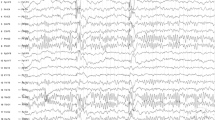Abstract
This report describes a rare case of primary cerebral venous dysgenesis in a 3-year-old child with development retardation. Angiography resulted in nonvisualization not only of deep cerebral veins but also of superficial cerebral veins. In computed tomography and in magnetic resonance imaging the collateral venous circulation appeared as a strange configuration in the pineal region. Single photon emission computed tomography using N-isopropyl-p-[I-123]-iodoamphetamine revealed decreased regional cerebral blood flow in the basal gangalia and thalamus, but cerebral infarction was not detected in the area. These features indicate that in this case, dysgenesis of deep cerebral veins, which probably occurred during prenatal life, had caused hypoperfusion in the deep cerebral regions.
Similar content being viewed by others
References
Byers, RK, Hass GM (1933) Thrombosis of the dural venous sinuses in infancy and in childhood. Am J Dis Child 45:1161–1183
Gabrielson TO, Seeger JF, Knake JE, Stillwill EW (1981) Radiology of cerebral vein occlusion without dural sinus occlusion. Neuroradiology 140:403–408
Gupta KL, Kapila A, Duvall ER, Rubin E, Vitek JJ (1987) Computed tomographic evaluation of deep cerebral vein thrombosis. Ala J Med Sci 24:41–45
Hill TC, Magistretti PL, Holman BL, Lee RGL, O'Leary DH, Uren RF, Royal HD, Mayman CI, Kolodny GM, Clouse ME (1984) Assessment of regional cerebral blood flow (rCBF) in stroke using SPECT and N-isopropyl-p(I-123)iodo-amphetamine (IMP). Stroke 15:40–45
Kagawa M, Shinohara T, Ogawa N, Beppu T, Kitamura K (1972) The study of cerebral venous disorder. No To Shinkei 24:1425–1431
Kagawa M, Shinohara T, Matsumori K, Kitamura K (1973) Intracranial venous and venous sinus malformation. No Shikei Geka 1:67–75
Kuhl DE, Barrio JR, Huang SC, Selin C, Ackermann RF, Lear JL, Wu JL, Lin TH, Phelps ME (1982) Quantitative local cerebral blood flow by N-isopropyl-p(123I)iodoamphetamine (IMP) tomography. J Nucl Med 23:196–203
Padget DH (1956) The cranial venous system in man in reference to development, adult configuration, and relation to the arteries. Am J Anat 98:307–356
Rouch ES, Riela AR (1988) Development of cerebral vasculature. In: Rouch ES, Riela AR (eds) Pediatric cerebrovascular disorders. Futura, New York, pp 11–32
Scotti LN, Goldman RL, Hardman DR, Heinz ER (1974) Venous thrombosis in infants and children. Radiology 112:393–399
Author information
Authors and Affiliations
Rights and permissions
About this article
Cite this article
Kato, I., Shirane, R., Ogawa, A. et al. Congenital cerebral venous dysgenesis. Child's Nerv Syst 8, 422–425 (1992). https://doi.org/10.1007/BF00304794
Received:
Issue Date:
DOI: https://doi.org/10.1007/BF00304794




